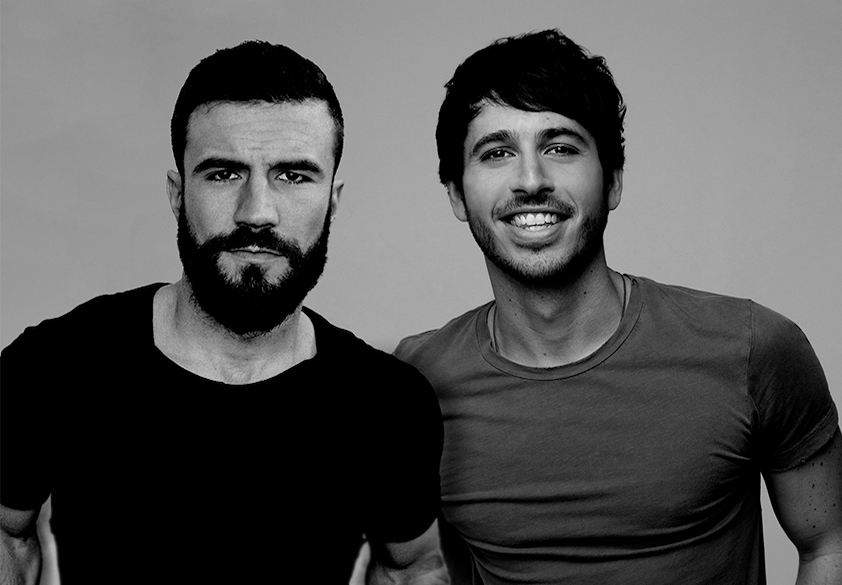Long road to radio: Sam Hunt & Morgan Evans lead country’s latest tilt at Top 40

While country artists Sam Hunt and Morgan Evans are carving out superstar careers in the US, Australian commercial radio has welcomed them with open arms.
Radio, take a bow. Not since Keith Urban and Shania Twain first captured middle American hearts in the 90s has Aussie pop radio sounded this wholesome.
Sam Hunt’s ‘Body Like A Back Road’ is currently peaking at #5 on the TMN Hot 100, and for good reason. Trickling with rustic pop undertones and words like ‘boondock’ and ‘Cadillac’, this country hit has an undeniable accessibility about it and just the right amount of palatability for radio.
“I had loved ‘Take Your Time’ from a few years back and just felt this would work for Nova,” says the network’s group program director Paul Jackson, the man responsible for championing ‘Back Road’ on Australian CHR.
“I totally expected it to go well – though to see the streaming numbers it has now, I didn’t expect that level of success.”
Hunt and Aussie country artist Morgan Evans, whose single ‘Kiss Somebody’ is sitting comfortably in the top half of the Hot 100, have both enjoyed a surprisingly enthusiastic reception from pop-wired audiences. They’ve tuned in for Justin Bieber and Ed Sheeran and stuck around for the rest, much to the delight of Jackson.
“Our view is always that if we’re going to play something a bit different, then we should really get behind it and see if we can get traction.”
‘Back Road’ got so much traction, in fact, that other major radio networks were left wondering what all the fuss was about – and wanting a piece. This ‘monkey-see-monkey-do’ pattern held true with KIIS jumping on the track a week later. Meanwhile, adds were steadily trickling in from various Hit stations. According to veteran country music promoter Rob Potts, it’s all about balancing risk and reward.
“None of that works if the radio PDs and CDs aren’t willing to take a few risks and right now,” Potts tells TMN, praising Jackson’s efforts. “With Nova leading the charge, there seems to be some appetite for risk.”
For Jackson and Nova, it’s not so much a matter of conforming to the traditional patterns of CHR; it’s more about finding that next big hit that will make a lasting impact in the market. Hunt and Evans ticked all the right boxes.

“We’re always looking for great songs with great hooks,” Jackson stresses, “and ‘Body Like A Back Road’ is essentially a great feelgood pop song. I think people’s tastes are broader than ever and am delighted they are both doing so well.”
Like any single vying for radio attention, behind-the-scene factors play their part. It’s not only the song that counts, but the strategy behind it. Shania Twain’s 1999 album Come On Over would never have sold 34 million copies worldwide if not for Mercury Records forcefully steering the ship and pushing obvious hit singles beyond country radio. With Hunt and Evans, Universal and Warner are holding nothing back.
“In each case, it comes down to bringing killer songs to the market,” Potts argues. “On top of that, you then have some very committed people at both [Hunt & Evans’] major labels having a red-hot go at gaining them a foothold in metro markets here.”
With local CHR on the label’s side, ‘Back Road’ and ‘Kiss Somebody’s seamless crossover sounds more like something you would hear coming out of the US landscape, not Australia. Australian radio is an entirely different kettle of fish, according to Tim Daley, Country Music Channel (CMC) group program director. Where in Australia country music has, for the most part, been floating awkwardly on the fringes with its strongest performance in regional markers and specialist radio formats, country artists in the US set the tone for everything else.
“Country is mainstream in the US, it is the #1 adult music format – so artists who have multiple hits at country radio appear regularly in other mainstream media, whether it be talk shows or reality TV.”
Potts agrees, explaining: “In the US, artists are very happy to remain within the country format as defined by radio because it is such a massive part of the radio landscape there with over 3000 dedicated country stations. When you get outside of these two markets though, the opportunity for country artists to gain exposure to mainstream and metro audiences is virtually nonexistent.”
“At this point, crossover potential can be the difference between establishing a global market or being restricted to the much smaller individual country markets outside of North America.”
Arguably, Hunt and Evans have hit that threshold, finding fans who don’t have to like Nashville to enjoy their music. The recent developments in Australian radio have proven to be a game changer for the genre and its crystallisation in the local market.
“It’s great to see pop radio in Australia embracing these two songs, but we have a long way to go to change the perception in cap city media that country music is second rate,” Daley says. “More exposure will certainly help, but the real key are more great songs.”
There’s plenty of that coming through, says Potts, who has his eye on a handful of local up-and-comers who have more than what it takes to make a breakthrough and conquer Australian radio.
“Keep an eye on Kelsea Ballerini and there are some great new young Aussie and Kiwi artists waiting for the opportunity to join the charge.”


